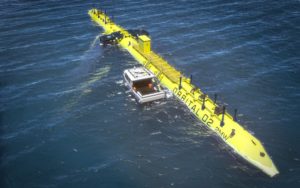Following news of U.S. oil giant Chevron’s entry into the offshore wind market and the observation that the company has yet to announce its zero emissions program, its Norwegian counterpart Equinor – which established its zero emissions commitments last year and already has “hands-on” experience in the offshore renewables sector – is set to update its existing energy transition plan.
The company will put the updates to an advisory shareholder vote at its future Annual General Meetings, starting in 2022, as it plans to review its energy transition plan every three years and report annually on the progress of the plan.
Equinor said it was one of the first companies in its sector to introduce such a measure, building on its evolving climate efforts, which date back to before 2018, when the oil and gas player changed its name as part of a strategy to transform into a broad energy company.
As the energy transition sweeps across oil and gas, major players are taking steps in several segments to reduce their own emissions and provide clean power and fuel to consumers. Shell, which has already entered the renewable energy market and has several hydrogen stations, has announced a new feasibility study to test the use of hydrogen fuel cells for ships.
The study will involve developing and installing a proton exchange membrane (PEM) auxiliary power unit fuel cell on an existing roll-on/roll-off (RoRo) vessel that transports goods, vehicles and equipment by truck between mainland Singapore and Shell’s manufacturing plant on Pulau Bukom. This will be the first study of its kind for both Shell and Singapore, with the aim of providing solutions for cleaner, hydrogen-powered shipping.
The use of fossil fuels in the shipping sector should be banned by 2030 if the industry is to meet its decarbonization efforts, according to a study by MAN Energy Solutions, which outlines four scenarios exploring how to achieve the shipping industry’s climate targets by 2050.
“Time is pressing: 2050 is just one ship generation away,” said Uwe Lauber, CEO of MAN Energy Solutions, further adding that a clear political course and global regulation are the key parameters for a successful maritime energy transition.
In addition to reducing the environmental footprint, decarbonization can also be a growth driver, according to the study, as only green shipping can meet the growing demand for international logistics if decarbonization is a global priority.
Green vessels have long been a reality and have been built as such to serve various sectors, including dredging, where Rohde Nielsen recently unveiled two new diesel-electric dredgers, Ask R and Embla R.
Both TSHDs are equipped with 600 kW battery packs, adapted diesel particulate filters (DPF) and selective catalytic reduction (SCR), and an advanced energy dispersion system that enables superior energy efficiency. Copenhagen-based Rohde Nielsen has stated that these are probably the most innovative and environmentally friendly downstream suction hopper dredgers (TSHDs) ever built.
Shipowners are not only investing in low-emission newbuilds, they are also equipping their existing fleets to prepare them for the future as the energy transition and ship decarbonization efforts progress on the path to reaching the 2050 global target. The latest ship operator to announce such an overhaul is Norway’s Eidesvik Offshore, which will modernize its Acergy Viking service operation vessel (SOV) as part of a plan to reduce its fleet emissions by 50% by 2030.
The 14-year-old vessel will be equipped with a battery pack and hybrid propulsion solution, and will be delivered in the first quarter of 2022.
The Acergy Viking will be deployed in an offshore wind project until 2027 under a contract with wind turbine supplier Siemens Gamesa, further reducing emissions within the offshore wind sector, considered the backbone of Europe’s energy transition.
Although it is the most mature and the most widely built, offshore wind is not the only renewable energy technology harnessing offshore resources around the world, with projects advancing in both the wave and tidal sectors.

Scottish tidal energy company Orbital Marine Power launched its 2 MW tidal turbine, nicknamed O2, from the port of Dundee, sending it on its way to the Orkney Islands. The operation to move the 680 tonne turbine from Forth Ports docks in Dundee to the River Tay was handled by Osprey Heavy Lift using a submersible barge.
The O2 will now be towed to Orkney, where it will be commissioned before being connected to the European Marine Energy Centre (EMEC). Once commissioned, it will become the world’s most powerful operational tidal turbine.
For companies working in the offshore renewable energy sector, opportunities are not limited to projects built off the coasts of countries. At least this is the case for Hellenic Cables and Asso.subsea, whose joint venture has won a contract for a subsea interconnection project for the Kafireas II onshore wind farm in Greece.
The wind farm, currently under construction, is located in the southernmost part of the island of Evia. Hellenic Cables and Asso.subsea will design, manufacture, supply and install a 150 kV submarine cable system to connect the 330 MW wind farm to the mainland, where Kafireas II will be connected to Greece’s electricity transmission system at IPTO’s 150 kV Lavrion substation.
